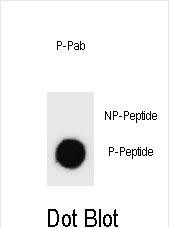Phospho-AMOT(S1041) Antibody
Affinity Purified Rabbit Polyclonal Antibody (Pab)
- 产品详情
- 实验流程
- 背景知识
Application
| DB, E |
|---|---|
| Primary Accession | Q4VCS5 |
| Other Accession | NP_001106962.1 |
| Reactivity | Human |
| Host | Rabbit |
| Clonality | Polyclonal |
| Isotype | Rabbit IgG |
| Calculated MW | 118085 Da |
| Gene ID | 154796 |
|---|---|
| Other Names | Angiomotin, AMOT, KIAA1071 |
| Target/Specificity | This AMOT Antibody is generated from rabbits immunized with a KLH conjugated synthetic phosphopeptide corresponding to amino acid residues surrounding S1041 of human AMOT. |
| Dilution | DB~~1:500 E~~Use at an assay dependent concentration. |
| Format | Purified polyclonal antibody supplied in PBS with 0.09% (W/V) sodium azide. This antibody is purified through a protein A column, followed by peptide affinity purification. |
| Storage | Maintain refrigerated at 2-8°C for up to 2 weeks. For long term storage store at -20°C in small aliquots to prevent freeze-thaw cycles. |
| Precautions | Phospho-AMOT(S1041) Antibody is for research use only and not for use in diagnostic or therapeutic procedures. |
| Name | AMOT |
|---|---|
| Synonyms | KIAA1071 |
| Function | Plays a central role in tight junction maintenance via the complex formed with ARHGAP17, which acts by regulating the uptake of polarity proteins at tight junctions. Appears to regulate endothelial cell migration and tube formation. May also play a role in the assembly of endothelial cell-cell junctions. Repressor of YAP1 and WWTR1/TAZ transcription of target genes, potentially via regulation of Hippo signaling-mediated phosphorylation of YAP1 which results in its recruitment to tight junctions (PubMed:21205866). |
| Cellular Location | Cell junction, tight junction. Note=Localized on the cell surface. May act as a transmembrane protein |
| Tissue Location | Expressed in placenta and skeletal muscle. Found in the endothelial cells of capillaries as well as larger vessels of the placenta. |
For Research Use Only. Not For Use In Diagnostic Procedures.
Provided below are standard protocols that you may find useful for product applications.
BACKGROUND
This gene belongs to the motin family of angiostatin binding proteins characterized by conserved coiled-coil domains and C-terminal PDZ binding motifs. The encoded protein is expressed predominantly in endothelial cells of capillaries as well as larger vessels of the placenta where it may mediate the inhibitory effect of angiostatin on tube formation and the migration of endothelial cells toward growth factors during the formation of new blood vessels. Alternative splicing results in multiple transcript variants encoding different isoforms.
REFERENCES
Bailey, S.D., et al. Diabetes Care 33(10):2250-2253(2010)
Heller, B., et al. J. Biol. Chem. 285(16):12308-12320(2010)
Talmud, P.J., et al. Am. J. Hum. Genet. 85(5):628-642(2009)
Gagne, V., et al. Cell Motil. Cytoskeleton 66(9):754-768(2009)
Zheng, Y., et al. Circ. Res. 105(3):260-270(2009)
终于等到您。ABCEPTA(百远生物)抗体产品。
点击下方“我要评价 ”按钮提交您的反馈信息,您的反馈和评价是我们最宝贵的财富之一,
我们将在1-3个工作日内处理您的反馈信息。
如有疑问,联系:0512-88856768 tech-china@abcepta.com.























 癌症的基本特征包括细胞增殖、血管生成、迁移、凋亡逃避机制和细胞永生等。找到癌症发生过程中这些通路的关键标记物和对应的抗体用于检测至关重要。
癌症的基本特征包括细胞增殖、血管生成、迁移、凋亡逃避机制和细胞永生等。找到癌症发生过程中这些通路的关键标记物和对应的抗体用于检测至关重要。 为您推荐一个泛素化位点预测神器——泛素化分析工具,可以为您的蛋白的泛素化位点作出预测和评分。
为您推荐一个泛素化位点预测神器——泛素化分析工具,可以为您的蛋白的泛素化位点作出预测和评分。 细胞自噬受体图形绘图工具为你的蛋白的细胞受体结合位点作出预测和评分,识别结合到自噬通路中的蛋白是非常重要的,便于让我们理解自噬在正常生理、病理过程中的作用,如发育、细胞分化、神经退化性疾病、压力条件下、感染和癌症。
细胞自噬受体图形绘图工具为你的蛋白的细胞受体结合位点作出预测和评分,识别结合到自噬通路中的蛋白是非常重要的,便于让我们理解自噬在正常生理、病理过程中的作用,如发育、细胞分化、神经退化性疾病、压力条件下、感染和癌症。






